Image may be NSFW.
Clik here to view.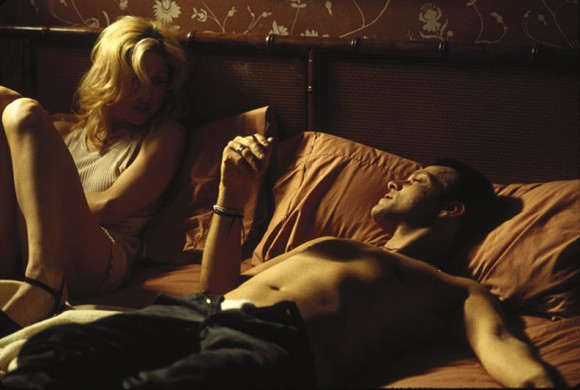
When Lou Reed died this week, the obituary consensus was that we’d lost the embodiment of “New York cool”—though if that really was all that there was to the man and his art, I would’ve said “Good riddance.” Reed was valuable not because he was a soaring rock n’ roll condor who shat onto the rest of us from such great heights, but because, in the studio at least, he was capable of relating recognizable human truths and shared frailties with unblinking eye-to-eye intimacy.
The latter quality, Reed’s vulnerability and empathy, which is so evident in his work of middle-age, has been widely overlooked in favor of his early, surly cool, and this is a crying shame. A line from Whit Stillman’s Damsels in Distress comes to mind: “Behind ‘coolness,’ isn’t there a certain repressing, squashing down or a lack of cultivation of one’s humanity?” To these two very different yet quintessentially New York figures, Reed and Stillman, I will add a third: Abel Ferrara. I have only seen Ferrara address the question of “cool” once. When speaking after a screening for his 2005 film Mary at Anthology Film Archives, Ferrara brought up Stephen Holden’s New York Times review of his film, in which a scene of Forrest Whittaker’s agnostic chat show host pleading with God is dismissed “excruciatingly embarrassing.” “Embarrassing?” Ferrara scoffed, straddling two chairs at the front of the theater, like the ham actor that he is. “He’s on his knees, begging God. What’s he supposed to be? Cool?”
Mary is about a director, Tony Childress (Matthew Modine), who’s just wrapped a Passion of the Christ-like project called This is My Blood, in which he stars as the Savior. Tony’s only religion is opportunist careerism, but the actress who played his Mary Magdalene (Juliette Binoche) can’t seem to shuck off the part. After ending the Blood shoot in Italy, she heads for Jerusalem on the trail of a living, contemporary Biblical reality.
Ferrara’s concern with the relationship between surface and subterranean truths is nothing new. In fact, the director’s greatest creation is a character called “Abel Ferrara,” a shambling, grizzled, reckless, perpetually drugged-up walking staph infection who just happens to have lined up financing for and successfully completed the shooting of twenty-some films since 1976—hardly a likely accomplishment if this persona was the whole truth and nothing but, though Ferrara is careful not to let the mask slip before his public.
Image may be NSFW.
Clik here to view.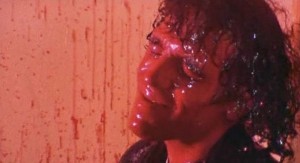 In Ferrara’s earliest, shoestring-budget works, he was in fact an actor. He made his debut feature, the XXX 9 Lives of a Wet Pussy, under the pseudonym “Jimmy Boy L,” and “performed” in it under the screen name Jimmy Laine; “Laine” returned to star in Ferrara’s next film and first official outing, 1979’s The Driller Killer. Subsequently Ferrara would leave acting to professionals—or, as often, to hand-picked non-professionals. In another sense, though, Ferrara’s never stopped putting on his wild man director act—Abel raising Cain, using a liquor store for a forwarding address, absently handing the phone over to Schooly D when he wants to check out of an interview, and greeted by name by every hard case, head case, and wino when walking down Ave. C.
In Ferrara’s earliest, shoestring-budget works, he was in fact an actor. He made his debut feature, the XXX 9 Lives of a Wet Pussy, under the pseudonym “Jimmy Boy L,” and “performed” in it under the screen name Jimmy Laine; “Laine” returned to star in Ferrara’s next film and first official outing, 1979’s The Driller Killer. Subsequently Ferrara would leave acting to professionals—or, as often, to hand-picked non-professionals. In another sense, though, Ferrara’s never stopped putting on his wild man director act—Abel raising Cain, using a liquor store for a forwarding address, absently handing the phone over to Schooly D when he wants to check out of an interview, and greeted by name by every hard case, head case, and wino when walking down Ave. C.
Modine’s Childress can be read as Ferrara’s unflattering self-caricature, and Willem Dafoe’s strip-club owner in follow-up Go Go Tales (2007) is Ferrara too—the director as hustler. Neither is quite so flagrant an impression as what Harvey Keitel gives us in 1993’s Dangerous Game. Keitel, the star of Ferrara’s Bad Lieutenant of the previous year, uses his familiarity with the director’s on-set demeanor to conjure up “Eddie Israel,” whose unkempt hair and perpetual drink-glued-in-hand slouch invokes Ferrara as unmistakably as any of the dozens of pseudo-Woodys that have graced Woody Allen’s filmography.
The beginning of Dangerous Game, then, defies expectation—it opens with a very domesticated Israel sitting down at a civil pasta dinner with his wife and young son. The mask is off! Ferrara had petitioned for Jane Campion, Keitel’s The Piano director, to play Israel’s wife, but instead wound up using his own wife, Nancy—thus adding a whole different extra-textual layer to the scene. Israel is preparing to leave his family and wintery Brooklyn behind to shoot a two-character psychodrama called Mother of Mirrors on a Los Angeles soundstage. The stars of Mother of Mirrors are Frank Burns, one of Israel’s cronies, and a popular TV actress named Sarah Jennings (James Russo and Madonna). Frank and Sarah are playing Russell and Claire, a couple in crisis. They’d once lived a harmoniously discordant life of mutual earthly indulgence, of swinging sex and booze and drugs. Now she’s had a religious relapse to the Catholicism of her youth, and he’s lost his job, endangering their perch in the upper-middle-class. Yet he continues to fuck, drink, and snort with abandon, berating her to reject the trappings of suburban materialism and rejoin him along the road of excess.
Writing in Cahiers du Cinema, Camille Nevers called Dangerous Game “a film in which [Ferrara] is ultimately not just foreman as well as architect but also active spectator and implicit and central actor.” The preceding quote was culled from a very fine 1993 piece by Kent Jones about Ferrara’s work generally and Dangerous Games specifically. Jones dwells at length on Ferrara’s idolization of Godard, specifically Godard’s burrowing, restless, relentless mission for cinematic truth, which frequently extends to pointing out what he perceived as hypocrisy in other filmmakers’ work. For an example of this, see JLG’s famously testy epistolary exchange with François Truffaut in 1973, in which he asks of the latter’s recent backstage drama: “I’d like to know why the director is the only one who doesn’t fuck in Day for Night.”
Image may be NSFW.
Clik here to view.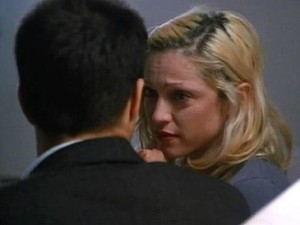 Well, Abel Ferrara/Harvey Keitel/Eddie Israel does his fair share of fucking in Dangerous Game. Eddie fucks his wife, a stewardess, and his starlet, who fucks Frank as research for her part. “Let’s get something straight, Burns,” she says afterwards, “You didn’t fuck me, you fucked the girl in the script.” All of this fucking is in the service of art, of course. But Dangerous Game’s vignettes, through their volatile, chafing proximity to one another, illustrate the impossibility of compartmentalization between domestic and working life, between life and art. Ferrara doesn’t make movies for an evening’s entertainment, but movies that endeavor to rip a hole through the fabric of the screen, like a fight that starts on a barstool then spills out onto the street and down the block. When a friend learned that I was going to be hosting a screening of Dangerous Game, he cheerily mentioned that he and his now-wife had nearly broken up after seeing it on a date twenty years earlier.
Well, Abel Ferrara/Harvey Keitel/Eddie Israel does his fair share of fucking in Dangerous Game. Eddie fucks his wife, a stewardess, and his starlet, who fucks Frank as research for her part. “Let’s get something straight, Burns,” she says afterwards, “You didn’t fuck me, you fucked the girl in the script.” All of this fucking is in the service of art, of course. But Dangerous Game’s vignettes, through their volatile, chafing proximity to one another, illustrate the impossibility of compartmentalization between domestic and working life, between life and art. Ferrara doesn’t make movies for an evening’s entertainment, but movies that endeavor to rip a hole through the fabric of the screen, like a fight that starts on a barstool then spills out onto the street and down the block. When a friend learned that I was going to be hosting a screening of Dangerous Game, he cheerily mentioned that he and his now-wife had nearly broken up after seeing it on a date twenty years earlier.
From what we see of it, film-within-a-film Mother of Mirrors looks to be one long, drawn-out, jagged, haranguing domestic row. Ferrara gave Keitel a free hand to direct these scenes himself, which creates another level of dissonance: James Russo is, after all, James Russo, and Harvey Keitel is Harvey Keitel, and whenever Eddie starts to walk Frank through a scene, Keitel’s initial interpretation is invariably more affecting than what Russo finally comes up with. “He can’t fuckin’ act,” Sarah shrieks of Frank, not inaccurately, pulling up her panties after a particularly brutal take, “He has to do everything for real.” It seems that Frank is using the script as a pretext to avenge his wounded pride for that earlier brush-off. Seeming to take Sarah’s side, Eddie steps in with the soothing mantra “The scene is over”—but if Dangerous Game shows us anything, it’s that the scene is never over.
Eddie and Sarah wind up in bed not long after this, and he narrowly misses being caught in flagrante delicto at the hotel when his wife makes an impromptu visit. Eddie’s guilt and professional distraction drives a wedge between them throughout the time that she’s in LA. After his wife leaves, parting on a note of reconciliation, Eddie is reading through a scene with Sarah. Her line “Be a man” seems to knock something loose in him, prompting him to vent: “Who the fuck are you to tell me how to be a man, Sarah, you commercial piece of shit?… If I left you on TV, you’d be selling toothpaste the rest of your life… You need me, I don’t need you.” There is a valid directorial justification for this: Eddie’s putting Sarah’s back against the wall, blindsiding her and forcing her to fight back, drawing a stronger, more defiant performance out of her. He also seems to be projecting his own hypocrisy onto her, and berating her for it. Once again, the set has become an arena in which scores from the outside can be settled.
Image may be NSFW.
Clik here to view.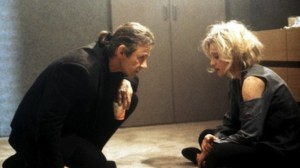 As Eddie brings the set home with him, so too does he take his home life onto the set. This tangle is made all the knottier as the film creates openings for us to introduce our own extra-textual knowledge of the production and its dominant personalities to the narrative. Late in the film, Eddie talks about his experience as a Marine, and those of us in the audience who know that Harvey Keitel was himself a member of the United States Marine Corp have to wonder—is this is Eddie talking, or Harvey? Is that Sarah Jennings carping “I’m not getting my picture taken by fucking Richard Avedon right now” between takes, or Madonna? There’s a sense that, as Eddie berates Sarah for being a “commercial piece of shit,” he’s also acting as Ferrara’s mouthpiece, berating Madonna for what she represents, and that the film is a sort of ambush that “The Material Girl” has been drawn into, in order to be stripped, slapped, choked, and humped.
As Eddie brings the set home with him, so too does he take his home life onto the set. This tangle is made all the knottier as the film creates openings for us to introduce our own extra-textual knowledge of the production and its dominant personalities to the narrative. Late in the film, Eddie talks about his experience as a Marine, and those of us in the audience who know that Harvey Keitel was himself a member of the United States Marine Corp have to wonder—is this is Eddie talking, or Harvey? Is that Sarah Jennings carping “I’m not getting my picture taken by fucking Richard Avedon right now” between takes, or Madonna? There’s a sense that, as Eddie berates Sarah for being a “commercial piece of shit,” he’s also acting as Ferrara’s mouthpiece, berating Madonna for what she represents, and that the film is a sort of ambush that “The Material Girl” has been drawn into, in order to be stripped, slapped, choked, and humped.
Nothing so simple. Any idea that this could be a “teach her a lesson” power play by a dictatorial rocker director avenging himself on his helpless pop starlet is strictly illusory, for Madonna was at this point entirely in control of her career, and very capable of reneging on a deal according to her mood—just three years earlier she dropped out of Jennifer Lynch’s Boxing Helena after committing to the lead role. Shortly before arriving on the set of Dangerous Game, Madonna had co-founded Maverick in partnership with Time-Warner, netting a reported $60 million advance and 20% royalty rate for her next seven albums (The deal was covered in The Times by none other than Stephen Holden!). Maverick’s film division, Maverick Picture Company—later Maverick Films—produced Dangerous Game, meaning that Madonna was very much the boss. Against this, Ferrara’s only collateral was his cult reputation, which, in retrospect, had already crested with the release of Bad Lieutenant. His only capitol was his chutzpah, his cajones. Luckily, trend-flitting Madonna has always been susceptible to the art-con—she made a movie starring the pütz from novelty band Gogol Bordello, for God’s sake!—so she went all the way down the line with her director.
Immediately previous to Dangerous Game, Madonna’s ambitions to become a legitimate screen star had been given a temporary boost when she was slotted into the lineup of the Rockford Peaches in 1992’s popular A League of Their Own—a casting coup probably achieved in a scene very much like that in Dangerous Game, where a CAA agent attempts to shoehorn one of her clients into Eddie’s movie over dinner. Madonna’s greatest big screen success then, and to date, however, is 1991’s Madonna: Truth or Dare, a behind-the-scenes tie-in to her 1990 Blond Ambition World Tour, directed by in-the-pocket camp follower Alek Keshishian. The film is divided between professionally-shot production numbers from the tour (filmed in color), and scenes of backstage drama co-starring her backup dancers, entourage, touring company, and family (filmed in “raw” black-and-white). There are also a number of celebrity cameos, including earnest, mulleted dork Kevin Costner, ill-treated by Madonna, and her then-paramour Warren Beatty, a reserved, bemused presence who speaks up only to voice his skepticism about the entire documentary project. “She doesn’t want to live off-camera, much less talk,” says 53-year-old Beatty of his 32-year-old girlfriend, “There’s nothing to say off-camera. Why would you say something if it’s off-camera? What point is there existing?” Thus ever has the elder generation tut-tutted the younger generation’s relationship to technology—see the circulation of Selfies at Funerals tumblr this week, built around the young and defiantly alive nose-thumbing at solemn mourning. (Madonna doesn’t get a funeral selfie into Truth or Dare, though she does do some infamous Voguing on her mother’s grave.)
Image may be NSFW.
Clik here to view.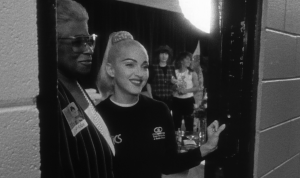 Dour old Beatty’s reservations aside, Truth or Dare upon its release became the highest-grossing documentary ever made, though box-office doesn’t even begin to describe the historical importance of this exhibitionist’s showcase of calculated candor, achieved through canny manipulation of the vocabulary of cinema verité. Almost exactly a year after the release of Truth or Dare, the first season of Mary-Ellis Bunim and Jonathan Murray’s new series The Real World premiered on MTV, taking place against a backdrop called “New York City” that had practically nothing in common with the similarly-named setting of Abel Ferrara movies.
Dour old Beatty’s reservations aside, Truth or Dare upon its release became the highest-grossing documentary ever made, though box-office doesn’t even begin to describe the historical importance of this exhibitionist’s showcase of calculated candor, achieved through canny manipulation of the vocabulary of cinema verité. Almost exactly a year after the release of Truth or Dare, the first season of Mary-Ellis Bunim and Jonathan Murray’s new series The Real World premiered on MTV, taking place against a backdrop called “New York City” that had practically nothing in common with the similarly-named setting of Abel Ferrara movies.
Like Keshishian, Ferrara uses different film stocks to differentiate the various strata of reality—though the latter doesn’t assert the objective truth of one over that of another. His alter-ego doesn’t handle such ambiguities quite so well; after a lifetime of straddling worlds, Eddie’s knees have begun to buckle, and he wants to reconcile the two hemispheres of his life. Honesty, as it happens, might not always be the best policy. Returning from LA for his father-in-law’s funeral, Eddie is overwhelmed by the need to divulge his history of infidelity to his wife… on the morning that her father’s going to be buried. Like most confessions, Eddie’s is self-serving, chiefly fulfilling the purpose of lightening the confessor’s guilt while placing the burden of unwanted knowledge on the person to whom it’s being confessed. Is there any crueler gesture in literature than Levin forcing Kitty to read his diary, with its full record of his affairs, in Anna Karenina?
The lead-up to this shows the full measure of Ferrara’s ability to set the table for a scene with just a few key details: The hush of the blue, snowy brownstone Brooklyn street outside, the living room crowded with condolence bouquets, the way Eddie and his wife keep their voices down so as not to wake their son who is sleeping upstairs, whom Israel had earlier quietly watched over, tenderly smelling his discarded socks. In a previous scene, Ferrara just as unforgettably got down the tone of a deck barbecue party on a crisp January day in the Hollywood Hills. Eddie’s wife teases his request for a turkey burger as “So California,” to which he responds, in his Brooklyn brogue, “That’s me, Mr. California.” When they’re back in New York together, and he’s unloaded the freight of his guilt, she’s less playful: “You’re nothing but a Hollywood piece of crap.”
Dangerous Game premiered at the Venice Film Festival under the title Snake Eyes, by which it’s still known outside of America, though the name was changed stateside for copyright reasons. Though it seems to have received some New York engagements, the movie was released straight to video in most of the country. Madonna, the production’s most salable asset, was in no mood to do publicity. After seeing the movie, she allegedly sent Ferrara a fax reading, “You fucker, you ruined my fucking career, you scumbag.” The Internet is lousy with citations of Madonna’s concise review of Dangerous Game, though the source of the quote is uncertain: “Even though it’s a shit movie and I hate it, I am good in it.”
If Madonna did indeed say this, she’s half right. She is good in Dangerous Game, for she gets to show off her most remarkable gift in it: The iron will that has allowed her to impress herself upon popular culture for over three decades despite no great inborn talent. Anyways, the Dangerous Game collaboration must’ve made sense on paper: Two Catholics with a penchant for mixing up the transgressive and the transcendent—and with elephant-like memories for nursing grudges.
Image may be NSFW.
Clik here to view. At one point, toward the end of Dangerous Games, Israel is seen watching Werner Herzog’s monologue about the personal cost of artistic monomania from Les Blank’s Burden of Dreams: “I shouldn’t make movies anymore. I should go to a lunatic asylum right away… Very much of it is too crazy, too… Not what a man should do in his life all the time…” This is of course relevant to Eddie’s dilemma, but it also takes on additional weight for those of us who remember the war of words between Herzog and Ferrara when Herzog was slated to direct a “sequel” to Bad Lieutenant for producer Ed Pressman. Herzog pretended (?) that he had never heard of Ferrara, who in turn expressed a wish that Herzog should “die in hell.” (They apparently squashed the beef at this year’s Locarno Film Festival.)
At one point, toward the end of Dangerous Games, Israel is seen watching Werner Herzog’s monologue about the personal cost of artistic monomania from Les Blank’s Burden of Dreams: “I shouldn’t make movies anymore. I should go to a lunatic asylum right away… Very much of it is too crazy, too… Not what a man should do in his life all the time…” This is of course relevant to Eddie’s dilemma, but it also takes on additional weight for those of us who remember the war of words between Herzog and Ferrara when Herzog was slated to direct a “sequel” to Bad Lieutenant for producer Ed Pressman. Herzog pretended (?) that he had never heard of Ferrara, who in turn expressed a wish that Herzog should “die in hell.” (They apparently squashed the beef at this year’s Locarno Film Festival.)
All of this seems not incidental to locating and understanding Dangerous Game, but rather essential. Every week Indiewire runs a “Criticwire survey” that collects responses from a variety of critics on the hot topic of a given week. This week’s survey was inspired by the public feud between Blue is the Warmest Color director Abdellatif Kechiche and the film’s star, Lea Seydoux, asking “Should critics ignore off-screen information in reviewing a film, or do they have an obligation to deal with it?” Let this stand as my long-form response.
Put concisely, when removed from the larger context of life, cinema doesn’t hold a great deal of interest to me—any more than any other medium when quarantined into sterile aesthetics. (I am writing in a week when Godard’s Contempt has arbitrarily been crowned “the coolest film of all time,” in language that wholly fails to convey anything of that movie’s value.) This shouldn’t come as a great surprise to any regular reader of this column (if such a creature exists)—indeed it’s been the running subtext from day one. The purpose of art, insofar as I can understand it, is to interface with, augment, and complicate life—even, as in Dangerous Game, to undermine it. In reflecting his characters’ self-delusions from disparate angles so as to create a portrait in the round, Ferrara practices cinema as the Mother of Mirrors. It’s also an opportunity to take a long, hard look at yourself.
Image may be NSFW.
Clik here to view. Nick Pinkerton is a regular contributor to Sight & Sound magazine and sundry other publications. He lives in Brooklyn, NY. Follow Nick on Twitter @NickPinkerton.
Nick Pinkerton is a regular contributor to Sight & Sound magazine and sundry other publications. He lives in Brooklyn, NY. Follow Nick on Twitter @NickPinkerton.